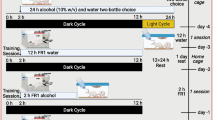Abstract
Rationale
Sardinian alcohol-preferring (sP) rats displayed high sensitivity to time schedule and consumed intoxicating amounts of alcohol during the last portion of the dark phase of the light/dark cycle when exposed to daily drinking sessions of 1 h, with concurrent availability of multiple alcohol concentrations and unpredictability of time of alcohol access.
Objectives
The present study investigated whether sensitivity of sP rats to time schedule extended to operant procedures of alcohol self-administration.
Methods
In experiment 1, three different alcohol solutions (10, 20, and 30 %, v/v) were concurrently available under a fixed ratio 4 schedule of reinforcement and with unpredictable time schedule; water was available uncontingently. Experiments 2 and 3 assessed the sensitivity of the motivational properties of alcohol to time schedule; rats were exposed to (a) self-administration sessions under the progressive ratio (PR) schedule of reinforcement and (b) sessions of alcohol seeking under the extinction responding (ER) schedule.
Results
In experiment 1, number of lever responses and amount of self-administered alcohol were positively correlated with time of alcohol access during the dark phase. When the self-administration session occurred at the first and latest hours of the dark phase, the amount of self-administered alcohol averaged 0.95–1.0 and 1.55–1.65 g/kg, respectively. In experiments 2 and 3, values of breakpoint and ER for alcohol were approximately 50 % higher when the sessions occurred at the last than first hour of the dark phase.
Conclusions
The reinforcing and motivational properties of alcohol were sensitive to time schedule and stronger at the end of the dark phase.





Similar content being viewed by others
References
Bell RL, Rodd ZA, Lumeng L, Murphy JM, McBride WJ (2006) The alcohol-preferring P rat and animal models of excessive alcohol drinking. Addict Biol 11:270–288
Bell RL, Rodd ZA, Engleman EA, Toalston JE, McBride WJ (2014) Scheduled access alcohol drinking by alcohol-preferring (P) and high-alcohol-drinking (HAD) rats: modeling adolescent and adult binge-like drinking. Alcohol 48:225–234
Colombo G, Lobina C, Carai MAM, Gessa GL (2006) Phenotypic characterization of genetically selected Sardinian alcohol-preferring (sP) and -non preferring (sNP) rats. Addict Biol 11:324–338
Colombo G, Maccioni P, Acciaro C, Lobina C, Loi B, Zaru A, Carai MAM, Gessa GL (2014) Binge drinking in alcohol-preferring sP rats at the end of the nocturnal period. Alcohol 48:301–311
Colombo G, Lobina C, Maccioni P, Carai MAM, Lorrai I, Zaru A, Contini A, Mugnaini C, Corelli F, Gessa GL (2015) Anxiety-like behaviors at the end of the nocturnal period in sP rats with a “history” of unpredictable, limited access to alcohol. Alcohol, in press.
Courtney KE, Polich J (2009) Binge drinking in young adults: data, definitions, and determinants. Psychol Bull 135:142–156
Finn DA, Belknap JK, Cronise K, Yoneyama N, Murillo A, Crabbe JC (2005) A procedure to produce high alcohol intake in mice. Psychopharmacology 178:471–480
Maccioni P, Pes D, Fantini N, Carai MAM, Gessa GL, Colombo G (2008) γ-Hydroxybutyric acid (GHB) suppresses alcohol’s motivational properties in alcohol-preferring rats. Alcohol 42:107–113
Maccioni P, Zaru A, Loi B, Lobina C, Carai MAM, Gessa GL, Capra A, Mugnaini C, Pasquini S, Corelli F, Hyytiä P, Lumeng L, Colombo G (2012) Comparison of the effect of the GABAB receptor agonist, baclofen, and the positive allosteric modulator of the GABAB receptor, GS39783, on alcohol self-administration in three different lines of alcohol-preferring rats. Alcohol Clin Exp Res 36:1748–1766
Maccioni P, Vargiolu D, Thomas AW, Malherbe P, Mugnaini C, Corelli F, Leite-Morris KA, Gessa GL, Colombo G (2015) Inhibition of alcohol self-administration by positive allosteric modulators of the GABAB receptor in rats: Lack of tolerance and potentiation of baclofen. Psychopharmacology 232:1831–1841
Markou A, Weiss F, Gold LH, Caine SB, Schulteis G, Koob GF (1993) Animal models of drug craving. Psychopharmacology 112:163–182
NIAAA National Advisory Council (2004) NIAAA Council approves definition of binge drinking. NIAAA Newsletter 3:5
Petit G, Maurage P, Kornreich C, Verbanck P, Campanella S (2014) Binge drinking in adolescents: a review of neurophysiological and neuroimaging research. Alcohol Alcohol 49:198–206
Rhodes JS, Best K, Belknap JK, Finn DA, Crabbe JC (2005) Evaluation of a simple model of ethanol drinking to intoxication in C57BL/6J mice. Physiol Behav 84:53–63
Richardson NR, Roberts DC (1996) Progressive ratio schedules in drug self-administration studies in rats: a method to evaluate reinforcing efficacy. J Neurosci Methods 66:1–11
Samson HH, Chappell A, Czachowski C, Sharpe A (2001) Measuring ethanol-seeking behavior: the effect of using repeated extinction trials. Alcohol 24:205–209
Sinclair JD, Hyytiä P, Nurmi M (1992) The limited access paradigm: description of one method. Alcohol 9:441–444
Thiele TE, Navarro M (2014) “Drinking in the dark” (DID) procedures: a model of binge-like ethanol drinking in non-dependent mice. Alcohol 48:235–241
Acknowledgments
The authors are grateful to Mrs. Carla Acciaro for animal breeding and care and Ms. Anne Farmer for language editing of the manuscript. Supported by NIAAA-funded “Integrative Neuroscience Initiative on Alcoholism” (INIA-Stress) Consortium.
Conflict of interest
The authors declare that they have no competing interest.
Author information
Authors and Affiliations
Corresponding author
Rights and permissions
About this article
Cite this article
Maccioni, P., Lorrai, I., Marras, M.F. et al. Elevated reinforcing and motivational properties of alcohol at the end of the nocturnal period in sP rats. Psychopharmacology 232, 3585–3595 (2015). https://doi.org/10.1007/s00213-015-4010-2
Received:
Accepted:
Published:
Issue Date:
DOI: https://doi.org/10.1007/s00213-015-4010-2




